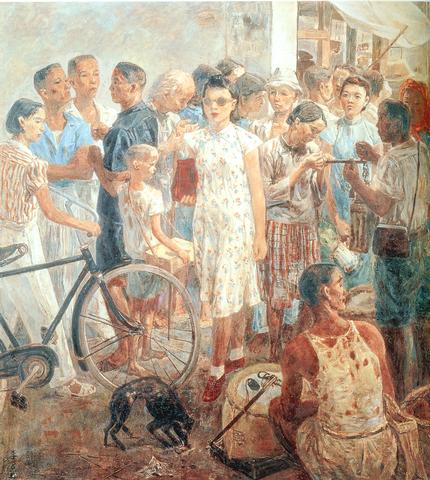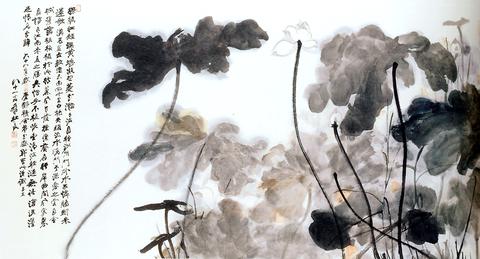Over the past decade, Taiwanese museums have begun in earnest to look into the country's neglected art history. This is nowhere more evident than in the current show Waves Striking: One Hundred Years of Taiwanese Arts at the Kuandu Fine Arts Museum in Taipei.
The show comes as the Taipei Fine Arts Museum (TFAM) also features a sweeping retrospective. But the Kuandu show -- the museum's grand opening exhibition -- contains a notably more sophisticated collection.
Whereas the pieces for the TFAM show were sourced from that institution's own collection, the museum's 100 pieces were loaned from over two dozen private collectors and museums. TFAM actually contributed 10 pieces and private collector and architect Glory Yeh (葉榮嘉), who runs his own art museum, has loaned two pieces.

PHOTO COURTESY OF LEE SHIH-CHIAO MUSEUM
A series of seminars and essays will accompany the exhibition as it attempts to comprehensively outline and define Taiwan's art history over the last century.
Framing the time period of the show -- which features paintings, sculptures and installations -- are a watercolor painting of the Taiwan Provincial Government Office by Kinichiro Ishikawa (石川欽一郎) dating from 1916 and a 1999 mixed media work titled Wounded Sadness by Chen Hsing-wan (陳幸婉). The artworks are categorized by theme, instead of by decade as in the TFAM show, to highlight the major trends in the development of Taiwan's art. Nonetheless, the themes provide a loose chronological thread that bears testament to Taiwan's history -- Reflection of Japanese Colonialism, Mood for Social Realism, Choices with Nationalist Awareness, Orchid Transplanted from the Mainland, Ink and Stroke for Self-Expression, Woodcuts with Left-wing Sentiments, Mighty Torrent of Modernism, Poetic Recall of Native Soil, Voice of Self-Awareness and Phantom of Virtual Reality.
The exhibition also differs from the TFAM show in its inclusion of non-native Taiwanese artists who were active in Taiwan, such as Kinichiro Ishikawa and Toho Shiozuki (鹽月桃甫), two Japanese artists and educators who had a lasting impact on the first generation of Taiwanese artists in the first half of the 20th century. The show also features Chang Da-chien (張大千), the famed Chinese ink painter, who emigrated to Taiwan in the 1950s and who had a profound influence as an artist and teacher of Chinese ink painting.

PHOTO COURTESY OF MU-HE LIN.
The show begins with a look at artists who worked during the 50 years of Japanese colonial rule. Their artwork reveals the influence of their Japanese teachers, many of whom studied in Europe and passed on the aesthetics of Impressionism popular at the time. Some, including Yang San-lang (楊三郎) and Chen Te-wang (陳德旺), studied in Japan. Chen's Mt Kuanyin, characterizes the impressionistic style with its quick strokes and globs of paint. Most of the paintings in this section focus on landscapes and figures, with Scenery with Coconut Trees by Liao Ji-chun (廖繼春) and Countryside in Taiwan by Lan Yin-ding (藍蔭鼎) -- one of the rare watercolor painters -- depicting quaint rural and natural scenes from a pre-industrial Taiwan. Another of the styles acquired from Japan is gouache painting, which in the show is represented by Lin Yu-shan's (林玉山) Lily Pond, which was also recently used as the backdrop for Cloud Gate Dance Theatre's Nine Songs.
In a different, more humanistic and socially observant vein are the pieces under the category of Mood for Social Realism taken from the 1930s and 1940s. Works by Chen Cheng-po (陳澄波), Lee Shih-chiao (李石樵) and Lee Mei-shu (李梅樹) are widely seen as defining representations of this pivotal period in Taiwan's history. Lee Shih-chiao's Entrance of a Market, for example, valued at more than NT$10 million, is one of his best known works and vividly portrays people during Taiwan's social transition immediately following the end of Japanese rule in 1945.
With the end of the Chinese Civil War in 1949 and the resulting flood of immigrants to Taiwan, traditional literary ink painting surged as a popular form of fine art. The Kuandu exhibition includes stunning pieces by Pu Xin-yu (溥心畬) and Fu Juan-fu (傅狷夫), whose hearts and imaginations clearly express the nostalgia felt by Chinese displaced to Taiwan.

PHOTO COURTESY OF ASIA ART CENTER
Some mainlander Taiwanese artists, however, reached beyond tradition and brought new elements to their rice paper scrolls. Foremost among these exhibited at the show is Chang Dai-chien, who integrated abstract painting to create his own style of "splash ink" painting, as seen in the piece Lily Pond.
In the post-war period, Taiwanese artists were swept up in the artistic trends that emanated from the US. The influence of abstract art, which became mainstream in the 1950s and 1960s, is visible in Lee Zhong-sheng's (李仲生) oil painting Abstraction and in Xiao Chin's (蕭勤) 1960 piece UA-90. Students who began to go overseas in large numbers in the 1970s returned from abroad with wholly new styles that have irrevocably changed Taiwanese art. Some of the featured artists from this period include Chen Hsing-wan's Wounded Sadness, Jun Lai's (賴純純) mixed media installation Super Aphrodisiac (1998) and sculptor Yuyu Yang's (楊英風) Dream Tower.
As a reaction to modernism, the Native Soil movement arose in the 1970s, and is characterized by a nostalgic look at Taiwan's people, architecture and other folk motifs. Representative folk-themed works by three masters of this period, Shi Te-chin (席德進), Ju Ming (朱銘) and Hong Tong (洪通), are prominently featured in this exhibition

PHOTO COURTECY OF YAGEO FOUNDATION
The show ends with artworks from the post-martial law period, which reflect the political and social upheavals of the 1980s and 1990s. Pieces such as Huang Chih-yang's (黃致陽) Phallic Worshippers, Chen Jie-ren's (陳界仁) Genealoge of Self and Wu Tien-chang's (王天章) The Rule of Chiang Ching-kuo exemplify the boldness of many of Taiwan's contemporary artists in dealing with such taboo topics such as sexual desire and violence.
The Kuandu exhibition is exceptional for its success in communicating the radical changes Taiwanese art has undergone. It also holds the promise of more outstanding shows at Taipei's newest museum. The show will move to Taichung in June.
Art Notes
What:
Waves Striking: One Hundred Years of Taiwanese Arts (千濤拍岸, 台灣美術一百年)
Where:
Taipei: Kuandu Fine Arts Museum, National Institute of The Arts, 1 Hsuehyuan Rd., Peitou, Taipei (北投國立藝術學院關渡美術館)
Taichung: Taiwan Museum of Art, 2 Wuchuan W. Rd., Taichung (台中國立台灣美術館)
When:
Taipei, until May 10th, 10am - 5pm;
Taichung, June 26 to July 29, 9am - 5pm.
Closed Monday at both locations.

This month the government ordered a one-year block of Xiaohongshu (小紅書) or Rednote, a Chinese social media platform with more than 3 million users in Taiwan. The government pointed to widespread fraud activity on the platform, along with cybersecurity failures. Officials said that they had reached out to the company and asked it to change. However, they received no response. The pro-China parties, the Chinese Nationalist Party (KMT) and Taiwan People’s Party (TPP), immediately swung into action, denouncing the ban as an attack on free speech. This “free speech” claim was then echoed by the People’s Republic of China (PRC),

Exceptions to the rule are sometimes revealing. For a brief few years, there was an emerging ideological split between the Democratic Progressive Party (DPP) and Chinese Nationalist Party (KMT) that appeared to be pushing the DPP in a direction that would be considered more liberal, and the KMT more conservative. In the previous column, “The KMT-DPP’s bureaucrat-led developmental state” (Dec. 11, page 12), we examined how Taiwan’s democratic system developed, and how both the two main parties largely accepted a similar consensus on how Taiwan should be run domestically and did not split along the left-right lines more familiar in

Most heroes are remembered for the battles they fought. Taiwan’s Black Bat Squadron is remembered for flying into Chinese airspace 838 times between 1953 and 1967, and for the 148 men whose sacrifice bought the intelligence that kept Taiwan secure. Two-thirds of the squadron died carrying out missions most people wouldn’t learn about for another 40 years. The squadron lost 15 aircraft and 148 crew members over those 14 years, making it the deadliest unit in Taiwan’s military history by casualty rate. They flew at night, often at low altitudes, straight into some of the most heavily defended airspace in Asia.

Many people in Taiwan first learned about universal basic income (UBI) — the idea that the government should provide regular, no-strings-attached payments to each citizen — in 2019. While seeking the Democratic nomination for the 2020 US presidential election, Andrew Yang, a politician of Taiwanese descent, said that, if elected, he’d institute a UBI of US$1,000 per month to “get the economic boot off of people’s throats, allowing them to lift their heads up, breathe, and get excited for the future.” His campaign petered out, but the concept of UBI hasn’t gone away. Throughout the industrialized world, there are fears that